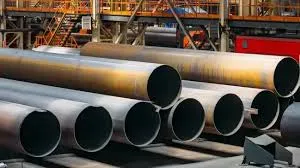In cases of low-pressure transportation, the use of ASTM A135 pipes is recommended. The electric-resistance-welded, or ERW, pipes are common in fire systems, water distribution, and even light mechanics. Among these classifications, ASTM A135 Grade A and Grade B are the most commonly used grades in comparison.
When buy ASTM A135 pipe, it is important to know the primary distinction between the two grades. The following will be an in depth comparison of Grade A and Grade B with respect to composition, mechanical properties, applications, etc.
What is ASTM A135 Steel Pipe?
ASTM A135 is a specification for electric-resistant welded (ERW) steel pipes for use in gas, vapor, water, or other liquid low-pressure pipe systems. These pipes are usually made of hot-rolled or cold-rolled steel coils and are ideal for light loads .
Grade A and Grade B of ASTM A135 are frequently used in construction, pipes for HVAC, plumbing and fire protection.
Chemical Composition: Grade A vs. Grade B
While both grades meet the same ASTM standard, there is a slight difference in the chemical composition which has an effect on strength and performance characteristics.
| Element | Grade A (%) | Grade B (%) |
| Carbon (Max) | 0.25 | 0.30 |
| Manganese (Max) | 0.95 | 1.20 |
| Phosphorus (Max) | 0.035 | 0.035 |
| Sulfur (Max) | 0.035 | 0.035 |
Observation: Grade B is more carbon and manganese grade A, therefore it is stronger but slightly less ductile.
Mechanical Properties
The mechanical properties of a steel pipe are crucial for assessing its durability and load-bearing capacity. Here’s how Grade A and Grade B compare:
| Property | Grade A | Grade B |
| Minimum Yield Strength | 30,000 psi (205 MPa) | 35,000 psi (240 MPa) |
| Minimum Tensile Strength | 48,000 psi (330 MPa) | 60,000 psi (415 MPa) |
Grade B has higher yield and tensile strength, and is therefore more suitable for applications working under higher pressures or mechanical loads..
Applications:
Although both grades are employed in the same arena, the difference in strength makes them slightly different in practical application.
Grade A Applications:
- Light mechanical works
- Residential fire sprinkler systems
- Low-pressure water pipelines
- HVAC ducting systems
Grade B Applications:
- Commercial and industrial fire sprinkler systems
- Light structural support
- Compressed air piping
- Systems with moderate mechanical loads
Grade A is adequate for the majority of residential and small commercial applications . If you need a project with a higher strength and resistance on the other hand you should use Grade B.
Weldability and Fabrication:
Weldability is also very good for both ASTM A135 Grade A and Grade B due to the low carbon composition. This also makes them easy to make and modify on site. Also, both can be bent, flared, and formed as long as they are worked within their strength capacities.
Grade A is also generally more ductile and slightly easier to work with during fabrication.
Surface Finish and Size Range
The grades come in the same surface finishes – black, galvanized, or coated – and are available with plain or threaded ends. These are manufactured in a variety of diameters from 1/2” to 10” and wall thicknesses needs.
Compliance and Certification:
ASTM A135 pipes meet many other standards, including NFPA 13 for fire protection systems. Pipes from reputable manufacturers such as uniasen.com are manufactured under quality control and according ASTM specifications. UNIASEN can provide full inspection reports along with certifications and testing data, should you need it to make sure your project meets all regulations.
Cost Consideration:
In terms of cost Grade A is usually less expensive because it has less material and is not as strong. Grade B might be a bit more expensive but it is superior performing in challenging conditions. Your millage will be determined by your project and budgetary needs.
How to Choose Between Grade A and Grade B?
Here’s a quick guideline:
- Choose Grade A if your project involves:
- Low-pressure systems
- High ductility requirements
- Lower budget constraints
- Choose Grade B if your project requires:
- Greater tensile/yield strength
- Higher pressure or load capacity
- Industrial-grade fire suppression or mechanical systems
Conclusion:
ASTM A135 steel pipes can be considered a good choice for low to medium pressure applications and both Grade A and Grade B, when used properly, should perform well . By knowing how they differ in terms of mechanical resistance, chemical composition, and use, you will be able to choose more wisely.
If you are starting a new pipeline project or upgrading an existing pipeline system, be sure you source from a certified supplier to ensure quality and performance. When you are ready to purchase ASTM A135 pipe, Uniasen’s offerings as your worldwide source for carbon steel products.
Related Post:
- Reid Russom – Purpose-Driven Educator and Leader!
- Numa Zara – Digital Fashion Revolution Blending Identity!
- Ecryptobit – Buy, Sell & Secure Digital Assets!
- Long Shooter – From Idioms and Film!
- Kick Flipper – Best Indoor Practice Board!
